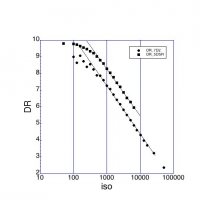I found in the film days that the native noise in the drum / film / slide scanner has a lot to do with the images final noise. Noise interference patterns occur between the film grain particle size and the CCD pattern noise in the scanner. Iso 200 Fuji Chrome had more noise than 800 iso print scans on my 2700 dpi scanner (approx 11.9 mp equivalent). Iso 50 and 100 looked way better...as did 400 iso. Certain brands of film at certain iso's seems to create mega noise due to the interference patterns. A friend of mine used a slightly higher resolution 4000dpi scanner only to find his beloved Velvia 50 scans were riddled with high iso noise and were unusable. Were as scans from my machine were far smoother at the lower native dpi. So yes...iso noise is a thing.
This used to be referred to as grain aliasing. (http://www.photoscientia.co.uk/Grain.htm) It was less about CCD noise and more about grain size versus scan resolution. But, yeah, certain films on certain scanners would have terrible grain. I'm surprised to hear about Velvia 50 because that always seemed to scan well for me at 2700 dpi or 4000 dpi.
That said, even compared to darkroom prints digital has a huge ISO advantage. ISO 3,200 shots from current APS-C sensors have a noise pattern comparable to tight grained ISO 400 print film. FF is comparable at ISO 12,800. I remember not wanting to shoot film higher than ISO 400 in 35mm format, but I have no reservation about pushing to 12,800 with digital FF.
I used to wonder if anyone would develop film profiles (like the digital modelling in guitar effects). But the reality is that most modern sensors far far exceed the dynamic range, contrast range and noise levels available on slide medium.
Yep. I do miss the color rendering of certain films, and the pre-canned film plugins never seem to get them quite right. But the flexibility I have in ACR/PS/LR to produce the colors and look I want far exceeds anything I ever had with film.
Upvote
0

